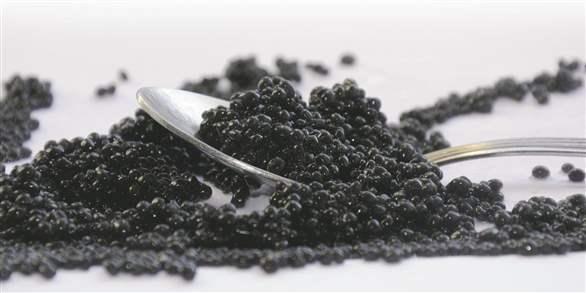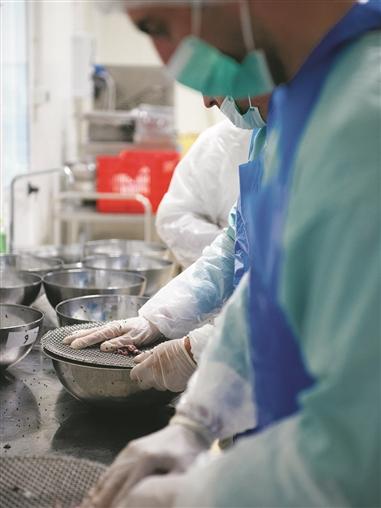How Caviar Is Processed
PROCESSING
This month’s Processing column continues with the “How is it processed?” theme, focusing on caviar. Caviar comes from the Persian word khaviar, which means “egg carrier.” Traditional caviar is the roe from wild sturgeon raised in the Caspian Sea and the Black Sea and has historically been called “black gold”; it is harvested from beluga, osetra, and sevruga sturgeon. Many countries include roe from other species of sturgeon, as well as other fish, such as salmon, trout, steelhead, carp, and whitefish, under the caviar label. According to U.S. Food and Drug Administration rulings, however, true caviar comes from sturgeon only.
Caviar was enjoyed by aristocratic Byzantine Greeks, who traded with Russia as early as the tenth century. Beluga caviar from the Caspian Sea is the most expensive variety of caviar, followed by osetra caviar. Its popularity has led to wild stock depletion due to overfishing. In 2005 the United States Fish and Wildlife Service banned the import of Caspian and Black Sea beluga caviar to protect the endangered beluga sturgeon. This was followed in 2008 and 2011 by Russia’s suspension of wild caviar production to replenish wild stocks. In recent years, a dramatic increase in “sustainable” caviar production from aquaculture farms has taken place.
Market Trends
The global market for caviar was valued at $276.2 million in 2018 (Grand View Research 2019). Osetra caviar is popular with high-income consumers, and its market value in 2018 was $72.1 million (Grand View Research 2019). It is available in a wide range of colors—from black to blue to yellow to green. A teaspoon of caviar can cost more than a family meal at some restaurants.
Sevruga caviar, noted for its flavor and texture, accounted for approximately 25% of global revenue in 2018 (Grand View Research 2019). In recent years, inexpensive caviar has become widely prevalent in the market and is readily consumed by beginner connoisseurs and enjoyed for its less fishy taste and darker color. Breaking sales out by form of caviar shows that freshly captured caviar held the largest market share in 2018, but interestingly, dried caviar is the fastest-growing form and is forecast to expand at a compound annual growth rate (CAGR) of 9.1% from 2019 to 2025. Preserved and frozen caviar markets are expected to increase at a CAGR of 8.4% for the same time period (Grand View Research 2019).
According to The Washington Post, China exported more than 130 metric tons of caviar in 2017, while the United States produced just under 16 metric tons. During the same year, the United States imported Chinese caviar valued at $7 million, five times the amount it imported in 2012. Concurrently, wholesale prices have fallen more than 50% (Reiley 2019). The Washington Post further reported that, according to the United Nations Food and Agriculture Organization, the import price has gone from $850,000 per ton in January 2012 to $350,000 per ton in November 2018.
Caviar has numerous positive health benefits. It is rich in proteins, omega-3 fatty acids, and selenium. A spoonful of caviar provides the adult daily requirement of vitamin B12. High-quality caviar is known for its firm texture, as well as its flavor qualities, which include a creamy and buttery taste, along with a mild fish finish.
Harvesting and Processing
Commercial growing and harvesting of caviar have become popular due to overfishing in the wild. Around the world, sturgeon are raised to produce caviar using aquaculture. Young fish require constant feeding and are fed high-protein pellets continuously throughout the day and night. As the fish grow, the frequency of feeding lessens. Bacteria are added into the grow tanks to remove toxic metabolites, and the tanks are monitored regularly to ensure optimum fish growth. After several months, the fish are transferred into larger tanks. The water from these tanks is continuously circulated to introduce oxygen and remove carbon dioxide gas produced by the fish. Solid waste is removed from the tanks by filtering the water through screens. In addition, the water circulates through plastic pieces that contain filtering bacteria, and molasses is added to the tanks to feed those bacteria.
It takes seven to 10 years for the fish to be ready to be harvested for its eggs. The eggs can account for 15% to 18% of the weight of the sturgeon. At this stage, the fish are typically at least a meter in length. Interestingly, there is no visual way to externally determine if a fish is male or female. For this reason, high frequency ultrasound is needed to determine not only the sex of the fish but also the egg development within the fish. Various methods are used to sedate the fish. These include exposure to carbon dioxide or sedatives, as well as sedation via low electric current. Once the fish are sedated, high frequency ultrasound is used to evaluate the sturgeon’s ovaries, or row sacks, and to evaluate the egg production in each fish, one at a time.
Small biopsies are also taken to visually observe the egg quality, including color and size. The color of the eggs in each fish varies, and there is no way to predict it. For example, “royal” caviar is golden and is found in only one in 1,000 osetra sturgeon. When ready for harvesting, the sturgeon will contain tens of thousands of eggs. At seven years of age, only about 10% to 20% of fish are typically ready for harvesting. Fish that are not yet ready are added back into the tank for another year of growth.
During the next processing step, the fish are purged in clean water tanks. This step is important to remove off-flavors. It is also important that the fish are not stressed at this or any stage of their growth. If the fish are stressed, they will reabsorb their eggs and need to go back into the growth chambers for another year or two to produce them again.
It is at this stage that the processing methods overlap for commercial fresh and farmed caviar. The fish are rapidly stunned, and the two ovaries are removed by a process called “stripping” that extracts the caviar through a small incision in the fish wall. Alternatively, the caviar can be extracted by performing a cesarean section, which can then be stitched up, allowing the female to continue producing roe. The third process for removal of the roe is by massaging the eggs out of the fish.
The very fragile eggs are then chilled and gently removed by hand from the membrane by rubbing the eggs against a mesh screen. The tissue is then removed for composting. The eggs are next rinsed repeatedly with cold water to wash away impurities, broken eggs, and membrane residues. Additional removal of crushed eggs and impurities is achieved by manual removal, using tweezers. The pure eggs are then poured into a fine mesh colander to remove the water.
The caviar is then weighed carefully and salted. Very fine salt is used in the process, and its addition is critical for optimal flavor and shelf life of the caviar. Lightly salted caviar is called “malossol” and has a salt content of less than 5%. Most high-quality caviar contains less than 3% salt. Caviar with a salt content up to 8% is called salted caviar or semi-preserved caviar, and its flavor is less fresh. If salt is added at greater than 10%, the product is called “payusnaya” and forms a jellylike cake that can be kept for three months.
The caviar is then chilled to allow it to absorb the salt for six minutes to several hours, after which it is drained again using a colander to remove water. After draining, it is dried further by carefully blotting it using a towel.
Now the caviar is ready for packing. Lacquer-lined tins are commonly used and are hand-filled and pressed gently to remove air. Air causes oxidation and spoilage during storage. The tins are then sealed tightly.
Caviar is typically aged for three months. Aging is critical for the final product flavor and for caviar to develop subtle fragrance notes. Longer aging is sometimes used. Caviar is perishable and requires refrigerated storage. Fresh caviar can be stored for two to four weeks. Caviar can also be pasteurized to extend shelf life and allow for storage times of up to a year at room temperature. Pasteurization is known to reduce quality in terms of final product texture and flavor, but it improves food safety. Other caviar preservation methods include freezing and drying, both of which extend shelf life.
Advances and Innovations
The largest area of innovation in terms of caviar in recent years has been the development of imitation, plant-based caviar, which is typically made from seaweed and can be enjoyed by vegetarians. Final product flavor and color mimic that of fresh caviar. It also lacks the cholesterol that is present in fresh caviar.
Another area of innovation for caviar is its use in cosmetics and health supplements. This area is growing rapidly.
The next time you enjoy caviar, please think of all that went into bringing this delicious delicacy to your table.
R E F E R E N C E S
Grandview Research. 2019. Caviar Market Size, Share & Trends Analysis. San Francisco. grandviewresearch.com.
Reiley, L. 2019. “After China turned it into a cheap snack, caviar is at risk of losing its status as a luxury good.” The Washington Post, April 22.






